Part 1: The Roots of Edible Landscaping and Forest Gardening in the Mediterranean

Source: mosaic from Santa Constanza, Rome, c.135 AD
“At the shade of a proud palm tree an olive tree sprouts, and under the olive tree, the fig and the pomegranate, and under that the grape. Under the grape the wheat, and then the leguminous. At last, the leafy greens. All that in the same year, and each one of them being fed at the shade of the other.”– Natural History, Pliny the Elder, c.77 AD
What many today consider a timeless rural landscape – the vineyard whose neat shows trace the curves of a Tuscan hill, the waves of grain that run across the Tiber River valley, or the regimented rows of olive monocultures sprawling across parched Iberian plains – are anything but ageless. Indeed, they are an extremely recent invention.
Edible landscaping, agroecology and forest gardening – the creation of productive environments conducive to human delectation and recreation that mimic the relationships, resilience, diversity, and dynamic processes of natural ecosystems – are modern phrases for practices stretching back into earliest antiquity. Eden, Shangdu, the hanging gardens of Babylon, the floating gardens of Xochimilco, are all superlative examples of edible landscaping.
The grape, the grain and the olive: with these primary colours as the basis of their palette, the diverse cuisines that constitute the Mediterranean diet have painted their faded frescoes, their titanic arabesques and their rustic vignettes across the canvas of fifty centuries. Yet the earliest historical records mentioning these crops, such as the Old Testament, often puzzle modern readers by the use of the term “vineyard” to denote a parcel of ground in which olive trees are planted. Based on textual and pictorial evidence, it is reasonable to conclude that in the ancient Near East, olive trees were planted amid grapevines.
In the Mishnah we read that the rabbis of two thousand years ago argued about what else besides olives could be planted in a vineyard without breaking “the law of diverse kinds”. Most agreed that vegetables, grains, and flowers could be planted in a vineyard, provided there was adequate spacing between the various species. They also discussed the question of training vines over non-fruit trees and fruit trees, and both the olive and fig tree are mentioned. A mosaic depicting a grape vine trellised onto the Tree of Life, discovered in the ruins of one of the oldest known synagogues, further attests to the long-lived prominence of forest gardening in the Middle Eastern regions of the Mediterranean basin.
On the other hand, throughout the European part of the Mediterranean – an area stretching from Greece through Italy, France and Spain, the coltura promiscua or coltura mista (translated as “promiscuous agriculture”, polyculture or mixed farming) landscapes predominated in many regions.
These were mosaics of mixed cultures on terraces, and are prominently depicted on paintings from the middle ages onwards, but were first developed by the indigenous Etruscans of central Italy three thousand two hundred years ago, well before the rise of the Roman empire. Like many native peoples, when they first began to cultivate vines the Etruscans did so in the same manner that they saw these plants grow wild in the woods (interestingly, a recent study on the origins of domestication suggests that the first cultivation of cereal monocultures in the fertile crescent was likewise inspired by the natural ecology of wild grains). The grape vine, vitus vinifera, is a climbing shrub, a species of liana. In a woodland, its natural habitat, it tends to climb up a tree to reach as much light as possible above the underbrush (it is a very light-loving plant). However, it is not a parasite: the vine does not weaken the tree on which it clings. The practice of growing trees as a living trellis for grape vines came to be known as “vite maritata”: married vine. Originally the vines were not pruned, later they were subject to long pruning. The grapes therefore tended to grow vigorously with very long shoots that were woven into intricate patterns festooned between the trunks of their support trees, or draped from crown to crown forming a solid green wall several stories high – the original “vertical gardening”. Farmers harvested the grapes with the hands or with sickles, with ladders or using instruments with a very long handle.
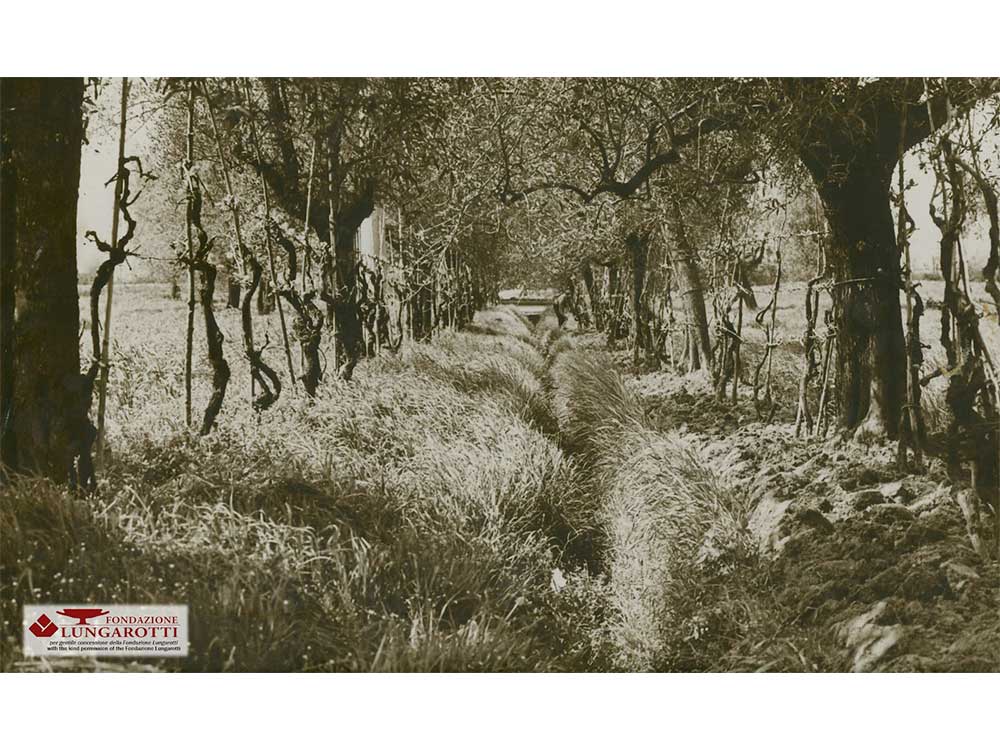
Early 20th century coltura promiscua demonstrating edible landscape design in three dimensions with canopy layer of maple, vine layer of grapes and herbaceous layer of cereals. Source: Lungarotti Wine Museum
Thus, the evidence suggests that domestication of grapes, which occurred independently in central Asia around the foothills of the Caucasus (from whence it spread to the Middle East and Greece) and again in central western Italy, was on both occasions developed in the context of a sophisticated indigenous polyculture.
Over time these evolved into landscapes with promiscuous cultures of tree crops (including olive, maple, elm, almond, walnut, poplar, as well as various fruit trees such as fig, mulberry, and pomegranate) “married” to grapevines. The trees, planted sparsely and pruned heavily so as not to shade the crops planted below, also provided leaves for animal forage, as well as fuel in the form of cuttings from the yearly coppicing (or, more accurately, pollarding). Between the rows of support trees and grapevines, a practice known in modern agroforestry parlance as “alley cropping” flourished, wherein companion plants, either perennials or annuals such as grains, vegetables, pasture, aromatic herbs, flowers, and legumes were planted in rotation, the latter of which provided nitrogen fixation and improved soil fertility. Two- or three-course rotations were most common, such as alfalfa-wheat (every fourth year), or rapid short-season rotations such as millet-lupine-turnip sown three times a year. Post-harvest stubble-grazing by sheep and goats, combined with mulching and controlled burning, completed the holistically managed regime. Thus, fertility was regenerated through animal integration and closed loop nutrient cycling.
These landscapes always had extensive transportation networks that connected fields, pastures, forests and settlements and enabled the spatial interrelations through the transport of livestock, yields, manure and other means of production. There was a more or less stable means of sustenance: drought might kill off winter wheat but hardier olives and grapes would survive, and farm animals could always be fed on a combination of leaf-forage and other forage gathered from the woods. The polyculture did not end strictly at the confines of the field, as rural people had (and continue to have) intimate knowledge of wild edibles. The forest was simply a less-ordered part of the coltura promiscua. Indeed, alongside the tree crops of the terraces, grazed nut tree stands of mountain woodland and forest were systematically integrated throughout Mediterranean mixed farming. These multifunctional stands belong to the broad category of indigenous tree crops with varying densities. Their management evolved over millennia and proved to be very sustainable as it is well adapted to local conditions, which implies that mostly no irrigation, fertilization and pesticides are needed. In fact, they are like a substitute nature, a semi-natural open forest. In the north, wild chestnut predominated under the name selva castanille, in the south, oaks and pine were the main species, under the name montado/dehesa.
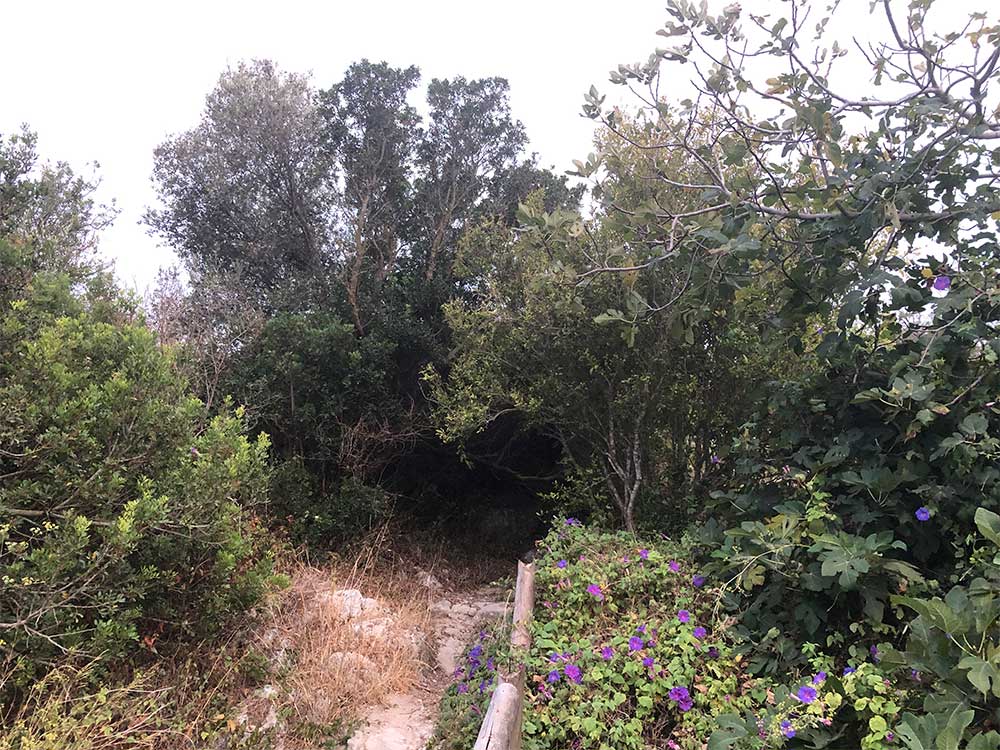
Mature (in fact, overgrown!) contemporary multi-layer Mediterranean forest garden in Vejer de la Frontera, Spain: Olive tree above Fig tree above Pomegranate tree above Pistachio tree above tree-trellised Morning-glory vine above an understory of perennial herbs and annual grasses
As in the complex multistrata agro-forestry practiced for millennia in tropical homegardens, in coltura promiscua farmers squeezed the maximum production out of the minimum of space through intensive interplanting. Because they could not, with their limited manpower and finances, purchase or work larger fields, sharecroppers and peasants intensified production on the land that they tended. This meant primarily using as much of the field as possible, i.e. going vertical.
Unsurprisingly, this traditional polyculture was truly sustainable: it lasted for more than three thousand years from the pre-Roman period of the Etruscans right up to the 1960s. A survey of the Umbrian region in Italy noted that in 1955, for vineyards, there were 126,550 hectares that were a mix of grain, vines, and trees, and only 1,520 hectares of “specialized vineyards” (i.e. monocultures of vines, what we think of when we hear the word “vineyard”). Over 98.8% of vineyards were mixed: “Vineyards were everywhere, but just vines were rare.”
In his Natural History, written in 77 AD, the Roman polymath Pliny the Elder stated that vines grown on living trellises produced the finest wines:
“The experience of ages, however, has sufficiently proved that the wines of the highest quality are only grown upon vines attached to trees, and that even then the choicest wines are produced by the upper part of the tree, the produce of the lower part being more abundant; such being the beneficial results of elevating the vine.”
Another advantage of this system was its resistance to disease. The history of phylloxera (Daktulosphaira vitifoliae), a bug that attacks the roots of European grapevines, seems a universal one, in that it quickly spread and destroyed huge swaths of vineyards starting in the mid-1800s. Yet the pest had a particularly late arrival in central Italy, especially in Umbria. Phylloxera was first noticed in Perugia in 1891, then reached the nearby city of Gubbio by 1899, but did not spread further. It reappeared in 1916 on the shores of Lago Trasimeno and only in 1933 reached Perugia again, as well as Foligno and Montefalco. Why the late arrival and slow spread? The reason was the “backwardness” of Umbrian agriculture: in other words, its use of the coltura promiscua. The roots of the grapevines in this system were stronger than those closely-spaced vines in monoculture vineyards, and their further distance from each other made transmission less likely. Even as late as the mid-1960s (when the last traditional fields were being ripped out) many of Umbria’s grapevines had not yet been attacked by phylloxera!
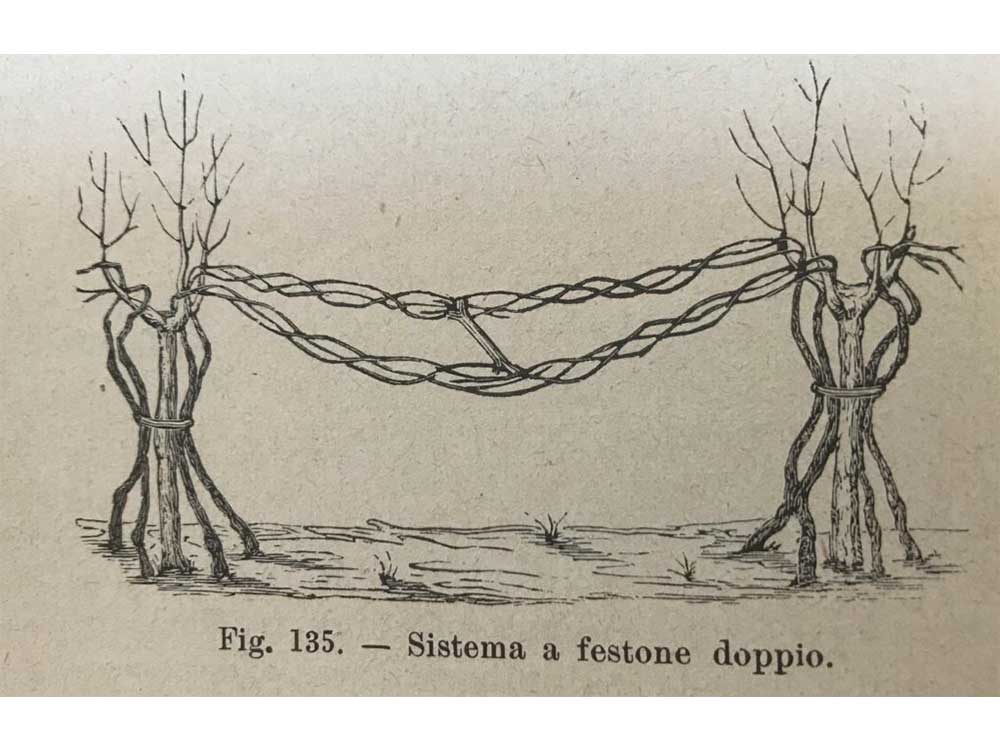
Source: guadoalmelo.it
In 19th century France, where the traditional polyculture involving tree-trellised vines was known under the name culture en hautains, a similar disease resistance was noted regarding a viticulture technique whereby vines were grown widely spaced apart and allowed to expand to large sizes. As Californian senator visiting France during the 19th century, when disease was ravaging the grape vines of Europe, noted:
“If phylloxera invades Touraine, it will be curious to note the resistance offered it by the vineyards cultivated en chaintres. In fact, in the canton of Montrichard, between Blois and Tours, this ingenious method of culture has been in vogue for forty years. Every vine covers an extent of ten square metres (about twelve square yards), and the development of its roots has an equal extent underground. It is quite presumable that a vegetation so extensive and so vigorous would at least be as resistant to phylloxera as the American varieties most renowned on this account. In the south, some viticulturists endeavor to protect themselves from the ravages of phylloxera by a method of culture en hautains, allowing the vines to grow high, which, like the method en chaintres, gives the vine great vigor and great extent of roots. I have always thought that that was the best antidote for the scourge. In fact, pruning the vine short is contrary to nature. This incessant mutilation of the vine, whose nature it is to spread indefinitely, weakens its vigor considerably; consequently we must not be astonished to see it succumb to the attacks of an insect.”
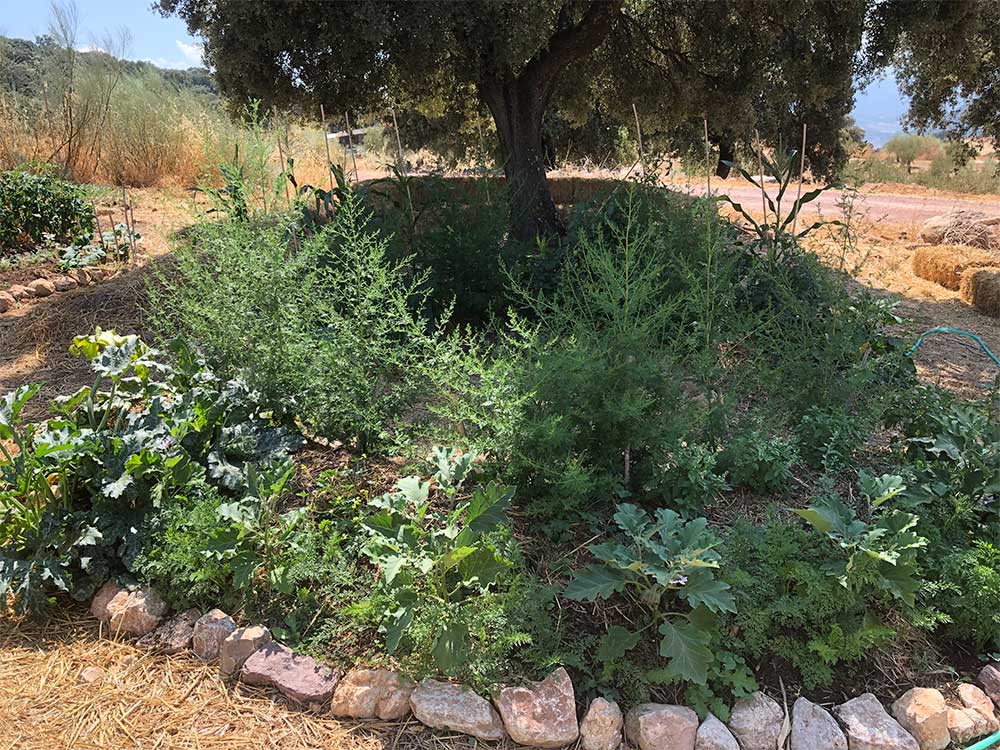
Modern intensive dehesa polyculture at La Donaira: holm oak, maize, tomato, yarrow, basil, marrow squash, aubergine and basil
Besides the agroecological benefits derived from these forest gardens, emerged an aesthetic delight scarcely imaginable to those accustomed to the one-dimensional farmlands of modern civilization. Roland de la Platière, a Frenchman traveling through Southern Italy in the 18th century, describes the agricultural landscape as a forest, in which there are clearings, mansions and cities, linked by magnificent avenues:
“All the surrounding countryside, up to Naples, are covered with vines supported by trees, poplars or maples, planted in a straight line to form wide avenues. The branches are pulled in the direction of the trees; and when they manage to touch each other, they bond together: in this way, when the leaf grows and the bunches grow on the horizontally elongated shoots, the weight gives them a festoon bend, which produces a fascinating effect. Imagine a whole countryside so adorned with garlands, vegetables and fruits that take color, and the lands beneath well cultivated with wheat, tubers, vegetables or artificial meadows, and you will have an idea of this excellent and beautiful country. It is, up to Naples, a continuous vegetable garden, with villas and country houses in large numbers and superb avenues. In the lowlands the eye is limited; one finds oneself in a forest; but the slightest height unfolds all these riches of nature with pomp and magnificence.”
The same scene led the Marquis de Sade, present in Naples in 1776, to think of a street parade during a carnival or country fair: “A superb road, flanked on both sides by large poplars and adorned with vine leaves. In short, everything gives the impression of a party.”
This system could only last as long as manual labour, rather than mechanization, predominated: “there was a duel to the death between the tractor and the tree.” Mixed fields could not be harvested with machines, which were ever-more widespread after the second World War. Industrial crop varieties and chemical fertilizers were other reasons for this system’s rapid disappearance. Another is the disappearance of the manpower and skilled labor needed to keep polycultures going, with the flight of rural people to the cities for better pay and the ease with which tractors could cultivate extensive fields. Intensive perennial polycultures became less profitable for landowners, leading to their near-total abandonment. However, now that the stable well-paying urban jobs which induced rural depopulation are becoming increasingly scarce in the post-industrial world, now that the global population is becoming more aware of both the immense ecological damage and ugliness produced by industrial farming as well as the immense beauty and promise of regenerative agriculture for restoring ecologies and livelihoods, now that a new generation of inspired, skilled individuals disaffected with big city life is turning back to the land in search of health and happiness – now, at last, the time has come to take a stand once again, loud and proud, in praise of promiscuous cultures.
Siddiq Khan
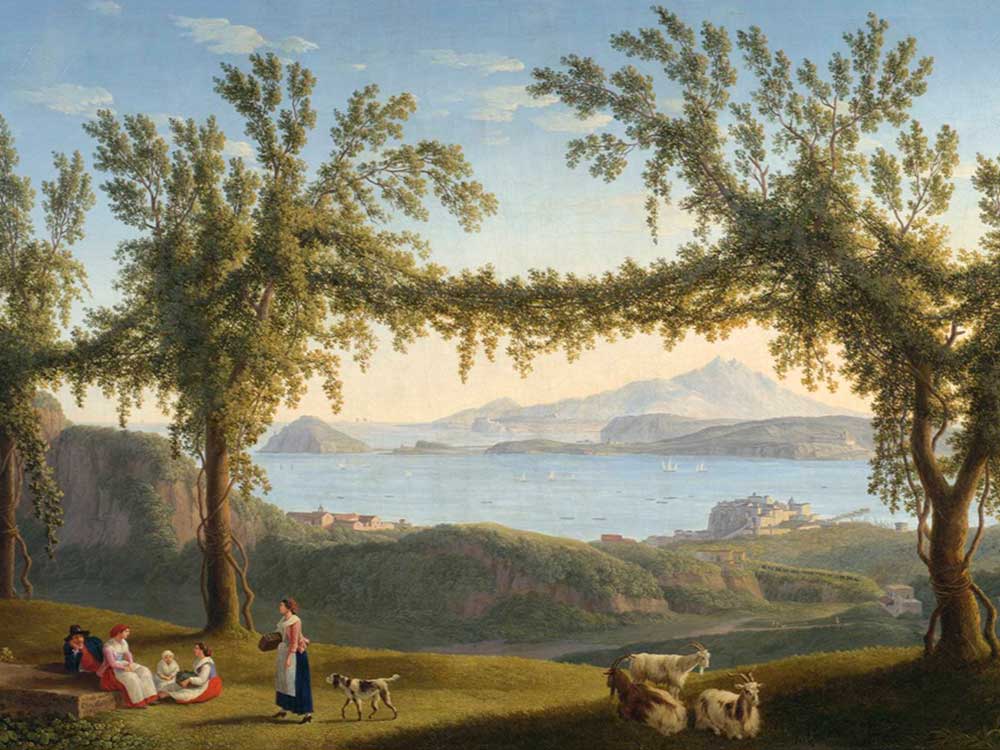
Source: Jakob Philip Hackert, Country Folk resting beneath the Vines in the Hills above Solfatara, with a View of Ischia, Procida and the Bay of Pozzuoli beyond, 1793
To be continued…
FURTHER READING
Agroecology: The Ecology of Sustainable Food Systems, by Stephen Gleissman
This book is widely regarded as the standard textbook on agroecology, which is a term used to describe three related concepts: firstly, the indigenous practices of working with nature to provide abundant means of life for communities invented around the world since time immemorial, secondly the science based on the study of these practices, and thirdly the global social movement working to advance the interests of these practices and the communities which sustain them.

Edible Forest Gardening by Dave Jacke and Eric Toensmeier
One of the most comprehensive attempts to map holistic design process onto the field of horticulture ever written. The geographic focus is on the North East United States but most of the material and principles (including extensive global species lists) are applicable everywhere.

Designing and Maintaining Your Edible Landscape Naturally by Robert Kourik
Thoroughgoing manual for edible landscaping based on agroecological principles

Teaser photo credit: Author supplied.





